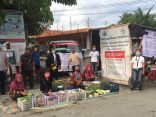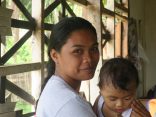by Sindhy Obias
In photo: Ma’am Joy (seated, first from right) and her co-teachers during the Disaster Preparedness Training for the school teachers in Talacogon.
Teaching is undoubtedly hard work. But for teachers in a small school that is flooded for at least three months in a year, the challenges are even more complex. Such are the circumstances of the elementary and high school teachers in Barangay Maharlika, one of the river barangays of Talacogon in Agusan del Sur province.
by Sindhy Obias
In photo: Ma’am Joy (seated, first from right) and her co-teachers during the Disaster Preparedness Training for the school teachers in Talacogon.
Teaching is undoubtedly hard work. But for teachers in a small school that is flooded for at least three months in a year, the challenges are even more complex.
Such are the circumstances of the elementary and high school teachers in Barangay Maharlika, one of the river barangays of Talacogon in Agusan del Sur province. Talacogon is part of the Agusan marsh, which serves as the catch basin of the Agusan-Davao plain in Eastern Mindanao. With its geographic location, communities along Agusan River like Barangay Maharlika experience slow-onset and prolonged flooding during the months of December until March. Maharlika Elementary School and its adjacent Maharlika High School have both five teachers, covering 204 and 58 elementary and high school students, respectively.
Travel to schools from the municipality’s Poblacion, around 25 kilometres away, normally takes two hours. Travel is by hired habal-habal (motorcycle) going to a small wharf in Barangay La Flora, and from there, a one hour and 30 minutes boat ride. During flooding season, Agusan River swells and transforms La Flora and other barangays along the river into a huge lake.
Mrs. Bennel Joy Vistal, the Head Teacher of Maharlika Elementary School said that teachers went through a lot of adjustments when they were assigned in the school. To be away from their family, to fit in the community’s language and culture, and work with insufficient school budget, were some of the struggles they had to deal with at the start.
But the most challenging part of their job, according to Ma’am Joy, comes during the flooding and typhoon season. For one, teachers like her who do not know how to swim are afraid of the water and have to be extra careful. Ma’am Joy recalls that, despite being at the community for almost nine years, her knees would shake after riding a small canoe – the usual mode of transportation available. There was an instance when a boat capsized and a fellow teacher nearly drowned, had it not been for community residents who rescued her in time.
Annually, for three months, land in the barangay is practically out of sight. Flood water, usually rising up to 20 feet high, would inundate the classrooms and turn the whole school grounds into a huge lake. Typhoon Agaton, which was experienced early this year, brought more rains than the previous years and caused the flood to rise up to 30 feet high. Frequent flooding would leave damages to school buildings, fixtures like chairs and tables, and learning materials.
Despite these difficulties, the teachers are happy with the strong ties and good relationships they have with the community and their students. Respect, trust, and solidarity are some of the values that the school teachers, students, and parents share as one community. The parents helped construct the floating cottages to house the teachers who are not residents at the barangay but would stay during the flooding season. Those who have houses that are big enough willingly offer to accommodate the children and use their houses as temporary classrooms.
Conducting the classes in floating houses would require teachers’ creativity, according to Ma’am Joy. They need to keep in mind that a floating house with too many children inside may capsize. This would mean less movement and classroom activities for have to be limited to story-telling and “desk work.” However, there are no desks and chairs, the students would all sit on the floor designated by their teachers.
It also helped that the schools and the community are part of the DRR Program of CARE Nederland and its partners ACCORD and AADC – the Scale Up, Build Up Project which concluded last year, and the Partners for Resilience Project which is being implemented until next year. Ma’am Joy shared that the lessons they learned from capacity building activities contributed to their heightened awareness on the risks that they are facing and provided them clear directions in addressing these risks. These learnings are important and timely for them now that the hazards are becoming more extreme and more frequent.
Through the discussions and workshops on integrating disaster risk reduction in their School and Community Improvement Plan, they were able to identify the measures to improve their conditions. The floating cottages for teachers were, in fact, conceived during one of their planning workshops. Floating cottages were made stronger to withstand strong winds during typhoons. They also realized that school investments for development like putting up structures should be well-planned, with the main consideration on the situation of the community. They have built a concrete fence in the past, only to be damaged by frequent flooding and typhoon. They now plan to use bamboos for the fence instead.
Communicating the risks and influencing the community to deal with the concerns related to disaster risk reduction, ecosystem management and restoration, and climate change adaptation are also some of the roles that the teachers are taking on. Classroom discussions now include lessons on DRR, EMR, and CCA to bring these concepts into the consciousness of the young students.
The schools plan to have mobile boats for the students. They are also thinking to have more “dormitory-type” cottages to house the children who are coming from far-flung areas in the barangay. Planting bamboos with the community is also one of the activities that the schools want to do.
Although the municipality of Talacogon plans to relocate the residents in the future, the community and the school have to go with the flow of rising waters whenever the Agusan River swells.




